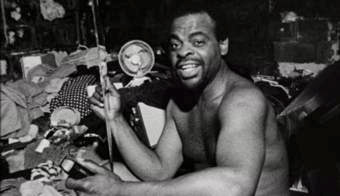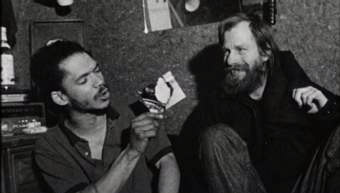|
OK,
pop quiz. Name the best ten documentary films you saw at
your local cinema last year. How about ten documentaries
that played at your local cinema last year? That
were released for cinema showing? Documentary is too often seen
as a televisual format, but many of
the finest documentary works were made for cinema distribution.
Frederick Wiseman made a career as a film documentarist with works
such as Meat, Hospital and the groundbreaking
Titicut Follies. English director Nick Broomfield
has developed a distinctive style of his own, seen to fine
effect in such works as Chicken Ranch, Biggie
and Tupac and Aileen
Wuornos: The Selling of a Serial Killer. And
let's not forget Errol Morris, whose Thin
Blue Line remains one of the most compelling examples
of the genre, and Michael Moore, who has achieved widespread
acclaim with Roger and Me and whose Bowling for
Columbine packed out cinemas across the world.
The
best documentaries take us places that we have never been, show
us a side of life we did not know existed or directly challenge
the established status quo and those supporting it, presenting
an alternative viewpoint of sometimes unjustly accepted
attitudes or beliefs. It is often the desire to expose the
truth that drives documentary film-makers, and their credibility
as film artists, as they use the medium to campaign or communicate
rather than to profit or further their own careers, is subsequently
often stronger than their counterparts in film fiction.
This was certainly the case with young British-born Marc Singer. Having spent some time in New York, he heard
about a group of homeless people who had built a small community in the Amtrack rail tunnels beneath the city,
complete with makeshift housing and jerry-rigged electricity. After getting
to know them and actually living with them a while, he decided
to make a film about them and their lives. The result is
the remarkable Dark Days.

The
situation itself is so extraordinary, and for most viewers
so surprising, that Singer is able to spend the twenty minutes
or so that make up the first act just introducing us to
the varied characters and the makeshift underground village
they have created. All are remarkable for
their resourcefulness, comradeship and good humour, finding
opportunity in the most unlikely situations and even looking
on homelessness as a form of freedom. We are a third of
the way through the film before the darker side of their story
begins to emerge – the drug addiction, the rats, the lack
of sanitation, the characters' sometimes heart-rending back
stories. The third act is unexpectedly narrative-driven,
with the intervention of city authorities bringing about
a momentous change for all living in the tunnel, one that
will have a dramatic effect on all of their their futures.
Make
no mistake, fascinating though the subject matter is, the
film does not trade on this alone. Having lived in the community
and won the trust of its naturally cautious inhabitants
before the idea of making the film was even suggested, Singer
gets closer to them than any professional crew could have.
As a result, all of those in the film react to Singer not
as subjects under his observation, but as friends.
Despite the title, this is anything but a dark movie – it
is an enlightening, uplifting and inspiring one, a compelling,
genuinely moving testament to the strength of the human
spirit.
Shot
in 16mm on what looks like Tri-X, a high contrast black-and-white
stock, this was never going to be reference material, but
even in the cinema this seemed wholly appropriate – a glossy,
well-lit, grain-free colour picture just would not have
worked anything like as well. This is recreated most effectively
on the DVD – indeed, considering the source material the
transfer here is impressive. Framed at the theatrical projection
ratio of 1.85:1 and anamorphically enhanced, it takes director
Singer, on the commentary track, to remind us that the original
aspect ratio was 4:3 and that it has been cropped for theatrical
distribution. He expresses a preference for the original
framing, but there are no examples to compare and the 1.85:1
framing looks fine and never seems too tightly cropped.

Two
mixes are included, Dolby 2.0 stereo and Dolby 5.1 surround. The 2.0 mix
is centrally weighted and on paper the
closest to the film's low budget identity, but the 5.1 mix is seriously
superior and does actually add to the film. Though the dialogue
is all confined to the centre speaker, the ambient sound
is much more expansive, spread across the front stage (there
is no real rear speaker action) and helps to create a sense
of place, pulling us into the tunnel far more effectively
than the 2.0 mix. Bass on the 5.1 mix is also very effective
in certain scenes, such as when Dee's house burns down or
during the opening shots of trains. D.J. Shadow's evocative,
low-key score definitely belongs in 5.1.
Another
example of a low budget independent film that has been given
four-star treatment. In such cases it is often the involvement
of the director himself in the disk that ensures a quality
release, and this is clearly the case here.
So
often the inclusion of a 'making of' documentary will prompt
a groan from DVD enthusiasts, as it is almost always little
more than an electronic press kit, a ten minute collection
of sound bites from principal cast and crew members intercut
with a few shots of them working on the film and some extracts
from the finished work. Actors tell us what sort of characters
they are playing, directors talk about what they "wanted
to do with this film" and everyone says what a great
project it has been to work on. Insight value: zero. Fortunately,
this is not always the case, and just occasionally you get
a look at the making of the feature that is revealing, compelling
and a decent length. The Making of Dark Days – A
True Independent most definitely qualifies. 46
minutes long and shot on 4:3 video with a Dolby 2.0
soundtrack, the story that unfolds in this straightforwardly
filmed but compelling extra is almost as remarkable as that
in the main feature. Director Singer and others from various
stages of the production reveal how someone who had never
held a camera in his life and had no film training whatsoever
brought an award-winning film to the screen through a series
of sometimes amazing chances and favours. Almost everything,
from the original conception and obtaining equipment to
lighting the tunnel, creating a dolly and even getting the
film processed, has a fascinating tale attached to it. An
excellent extra that compliments the film perfectly.
The
feature commentary by director
Marc Singer inevitably repeats some of the stories found
in the documentary, but still delivers a great deal of new
information about the characters and the process of making
the film. There are very few dead spots and Singer has an
engaging delivery style, never for a second coming over
as pretentious or self-important. Singer clearly cared a
great deal for those in his film and this comes across in
spades.
A
total of fifteen Deleted Scenes
are included, most of them quite short, all of them featuring
the main characters from the film. Though no startling new
information is provided by these scenes (otherwise, we presume, they
would have been included), all the extra material is interesting,
some of it very funny, and it helps us connects even more
effectively with the characters, which itself helps serve
the purpose of the film. Every deleted scene is proceeded
by context-setting introductory notes from Marc Singer.
A
History of the Tunnel by Margaret Morton is
a textual history of how communities developed within the
tunnel. Though short, it is still an essential read.
Life
After the Tunnel is a text-based feature in
which Marc Singer relates what has happened to all of the
principal characters in the time between the completion
of the film and the release of the DVD. Unlike many text
features, this is essential reading and provides a sometimes
inspiring, sometimes sad postscript to the film. Definitely
do not read this before seeing the main feature.
Short
Biographies of the film-makers
are provided, as is a very simple, 1 minute, 4:3 trailer
for the film and three web links to relevant internet sites.
Selecting
the Palm Pictures logo on the main menu will give you the
only out-of-character extra on the disk, a 4:3 trailer for
one of their other releases, the anime feature Blood:
The Last Vampire.
Dark
Days is essential cinema, a compelling, eye-opening
documentary and a genuinely humanist work that takes us
to the underside of society and blows away our preconceptions,
forcing us to re-evaluate our view of the homeless, which
was director Singer's intention in the first place. The
DVD is very well specified, sporting a strong transfer,
a fine soundtrack, a splendid making-of documentary and
a fascinating commentary track. Highly recommended.
|